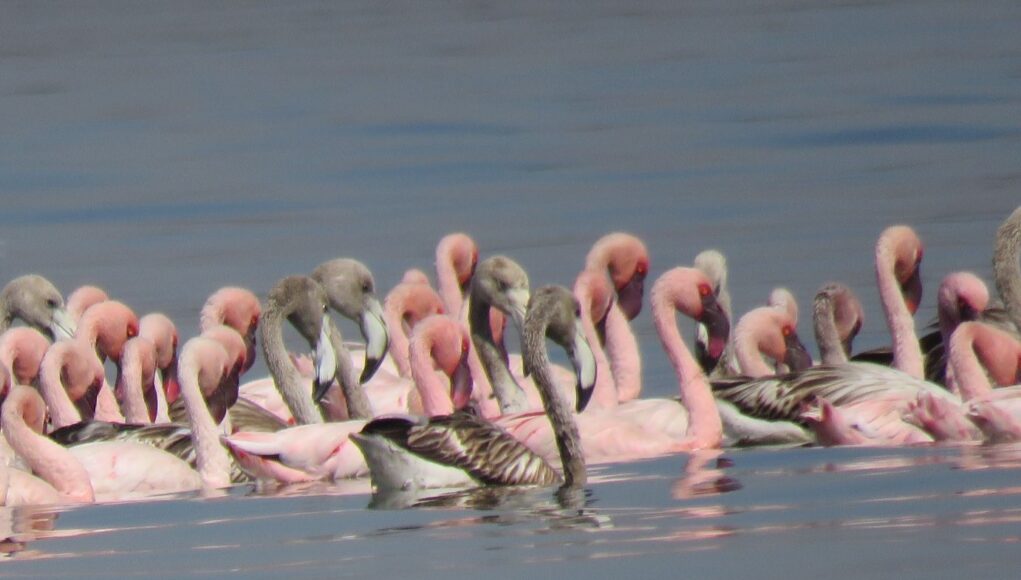Flamingos are migratory birds that visit Mumbai every year from October to March. They come to the mudflats and wetlands of Mumbai to feed on the algae and small organisms found there. They come in tens of thousands, and create a striking visual spectacle that has become a popular attraction for tourists and birdwatchers. They come from their breeding grounds in the Middle East, Central Asia, Europe and Siberia.
Why Flamingos come to Mumbai?
These birds undertake a long-distance migration to escape the harsh winters of their breeding grounds and to find food in the warmer climates of Mumbai’s mudflats and wetlands. These lands of Mumbai provide an abundant supply of small organisms, such as algae and small crustaceans, that the flamingos feed on. The shallow waters of these areas also make it easier for the flamingos to wade through the water and filter feed with their long, curved bills.
Video of boat ride at Thane Creek:
Where to find flamingos in Mumbai?
The best places to spot flamingos in Mumbai are the Sewri mudflats and Thane Creek.
Sewri is particularly famous for its large flocks of flamingos, and it has become a popular destination for birdwatchers and nature enthusiasts. But access to Sewri have been stopped due to construction of Mumbai-Trans-Harbour Link (MTHL) which will connect Mumbai to Jawaharlal Nehru Port (Navi Mumbai).
Thane Creek can be accessed which is managed by Thane Creek Flamingo Sanctuary.
Types of Flamingo
The flamingos that can be seen in Mumbai are primarily the Greater Flamingo (Phoenicopterus roseus) and the Lesser Flamingo (Phoeniconaias minor). The greater flamingo is the larger of the two, with a height of up to 140 cm, while the lesser flamingo is smaller, standing at a maximum of 90 cm.
The Greater Flamingo is the most common species seen in Mumbai, and it has a pinkish-white plumage with black-tipped wings. The bill is long and pink with a black tip, and it is used to filter feed in the shallow waters of the mudflats. The greater flamingo also has a distinctive “knee” joint in its long legs, which allows it to stand in the shallow waters for extended periods of time.
Here are the photos of Flamingos with other bird species at Thane Creek – Scroll the images (left or right)

The Lesser Flamingo is a more vibrant pink in color, with a darker pink wing coloration. It has a shorter, darker bill and a more curved beak than the greater flamingo. The lesser flamingo is a smaller species and is not as commonly seen in Mumbai as the greater flamingo.
Both species of flamingo are beautiful and fascinating birds to watch, and they make for a unique and memorable sight in the bustling city of Mumbai.
As per the Bombay Natural History Society (BNHS), the highest number of flamingos has been recorded across Mumbai between December 2021 and March 2022. The Thane Creek Flamingo Sanctuary recorded 54000 greater flamingos while Sewri 17000 and Nhava Seva 227.
About Thane Creek Flamingo Sanctuary
You can visit Thane Creek Flamingo Sanctuary.. It is a treat, especially for the kids. Boat rides take place only during high tides since it is easy to reach closer to the birds and navigate. At Thane and Bhandup, you will see many other migratory birds, as well as indigenous animals, and insects. These regions are high-level biodiversity spots.
Tips during visit: It’s important to note that visitors should be respectful of the birds and their habitat. They should not disturb the birds, make loud noises, or litter the area. It’s also important to take precautions against the sun, such as wearing sunscreen and a hat, as well as bringing water to stay hydrated.
Related links:
- Visit Thane Creek Flamingo Sanctuary
- BNHS – Flamingo
- Mumbai’s favourite flamingo watching site at Sewri to be closed for at least 7 years








